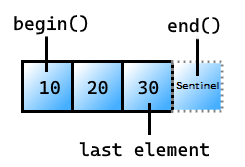drop_view class (C++ Standard Library)
Create a view that excludes the first N elements of a range.
Syntax
template<ranges::view V>
class drop_view : public ranges::view_interface<drop_view<V>>;
Template parameters
V
The type of the underlying view.
View characteristics
For a description of the following entries, see View class characteristics
| Characteristic | Description |
|---|---|
| Range adaptor | views::drop |
| Underlying range | Must satisfy output_range or higher |
| Element type | Same as the underlying range |
| View iterator category | Same as the underlying range |
| Sized | Only if the underlying range satisfies sized_range |
Is const-iterable |
Only if the underlying range is const iterable and satisfies random_access_range and sized_range |
| Common range | Only if the underlying range is a common_range |
| Borrowed range | Only if the underlying range satisfies borrowed_range |
Members
| Member functions | Description |
|---|---|
| ConstructorsC++20 | Construct a drop_view. |
baseC++20 |
Get the underlying view. |
beginC++20 |
Get an iterator to the first element. |
endC++20 |
Get the sentinel at the end of the view. |
sizeC++20 |
Get the number of elements in this view. The underlying range must satisfy sized_range. |
Inherited from view_interface |
Description |
backC++20 |
Get the last element. |
dataC++20 |
Get a pointer to the first element. |
emptyC++20 |
Test whether the drop_view is empty. |
frontC++20 |
Get the first element. |
operator[]C++20 |
Get the element at the specified position. |
operator boolC++20 |
Test whether the drop_view isn't empty. |
Requirements
Header: <ranges> (since C++20)
Namespace: std::ranges
Compiler Option: /std:c++20 or later is required.
Constructors
Construct an instance of a drop_view
template<ranges::view V>
class drop_view : public ranges::view_interface<drop_view<V>>
Template parameters
V
The type of the underlying view.
Return value
A view of the underlying range, excluding the specified number of elements from the front.
If you specify more elements to drop than exist in the underlying range, then an empty_view is returned.
Remarks
The best way to create a drop_view is by using the views::drop range adaptor. Range adaptors are the intended way to create view classes. The view types are exposed in case you want to create your own custom view type.
Example: drop_view
// requires /std:c++20 or later
#include <ranges>
#include <iostream>
#include <vector>
int main()
{
std::vector<int> v{ 1, 2, 3, 4, 5 };
auto newView = std::views::drop(v, 3);
for (auto e : newView) // outputs 4 5
{
std::cout << e << ' ';
}
std::cout << '\n';
auto numbers = std::views::iota(0) | std::views::take(10); // generate a view of 10 integers
for (auto i : numbers | std::views::drop(5)) // use the '|' syntax to create a drop_view
{
std::cout << i << ' '; // outputs 5 6 7 8 9
}
}
4 5
5 6 7 8 9
base
Gets a copy of the underlying view.
// Uses a copy constructor to return the underlying view
constexpr V base() const& requires std::copy_constructible<V>;
// Uses a move constructor to return the underlying view
constexpr V base() &&;
Parameters
None.
Return value
The underlying view.
begin
Get an iterator to the first element in the drop_view.
constexpr auto begin()
requires (!(Simple_view<V> && ranges::random_access_range<const V> && ranges::sized_range<const V>));
constexpr auto begin() const
requires ranges::random_access_range<const V> && ranges::sized_range<const V>;
Parameters
None.
Return value
An iterator pointing at the first element in the drop_view.

end
Get the sentinel at the end of the drop_view
constexpr auto end() requires (!Simple_view<V>);
constexpr auto end() const requires ranges::range<const V>;
Parameters
None.
Return value
The sentinel that follows the last element in the drop_view:

size
Get the number of elements in the drop_view.
constexpr auto size() requires ranges::sized_range<V>;
constexpr auto size() const requires ranges::sized_range<const V>;
Parameters
None.
Return value
The number of elements in the drop_view.
Remarks
The underlying range must satisfy sized_range.
See also
<ranges>
drop range adaptor
take_while()
take_while_view
View classes